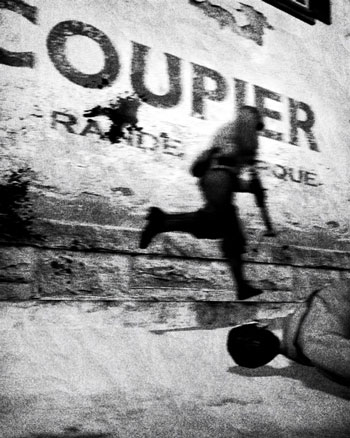"Games Are Perfect Artmaking Tools": An Interview with Kent Sheely

Kent Sheely is an American digital artist living in New York City who makes art out of, and about, video games. His work includes real-life installations of Super Mario Boxes, classic war-photography in Day of Defeat and the photography-hack Grand Theft Photo. I wanted to know more about Kent's approach to video games and asked him a few questions by email. His portfolio can be viewed at his site.
VGT: Why video games? ;)
Kent: When I was a kid, I used to draw up new adventures for my favorite game characters, incorporating their 8-bit worlds into those from my own imagination. I was never satisfied with just playing the games; I was driven to take them to new places. I guess that sensibility just evolved as I grew up and started finding out about other artists who were using video games to create art. They were validating my obsession.
Games are perfect artmaking tools, because like art, they already abstract the real world and can provide new perspectives on it. They're also a window into both current and nostalgic pop culture, since they have grown up alongside our current generation. It's an ever-evolving medium.
A majority of my work centers around taking elements from either the real or virtual realm and finding ways to interpret them in the other, like a mashup between simulation and reality. It's that grey area that I find most interesting.
.
"Ready for Action" (2012) shows video game protagonists at the mercy of public transportation: Ready for action, powerless to act. Audio from the game has been blended with audio captured while waiting for public transportation in the real world.
.
Part of your work focusses on glitches, another on the juxtaposition of game graphics and real life. Is photorealism, that eternal industry goal, relevant?
The answer is both yes and no. It all comes down to what I'm trying to accomplish at the time.
With my work involving glitches, the original appearance generally doesn't matter, as any shred of realism generally gets pulled apart anyway. I'm more focused on hijacking the graphics engine to create something that's interesting to look at, rather than just distorting the game. I like seeing the bold, stark colors and shapes of GTA: San Andreas stretched across the screen into impossible shapes, with recognizable but cartoonlike objects occasionally poking through the chaos. The game graphics become something akin to oil paint.

Games have been evolving over the years to become more realistic, to blur the line between fantasy and reality and provide the player with a more "authentic" experience. Making the brain question reality, even for a moment, heightens the experience and creates a more immersive environment. But, like abstract paintings, video games don't have to be realistic to be successful in communicating with the viewer/player. Sometimes the details that our minds fill in are more important than what's actually on the screen. Photorealism produces images that are closer to the real world, but even simple simulations have graphics that successfully represent abstract ideas. The way a player/viewer connects with those symbols is more important than perfectly mimicking reality. Our brains are pretty good at filling in the gaps.
Because of this fact, I've tended to focus more on the concept I'm aiming for, or on a specific mechanic I want to explore, rather than choosing titles with more realistic environments. For example, the simple detail of the in-game camera in GTA: San Andreas is what led me to make Grand Theft Photo, a hack that limits players to using the camera rather than any of the weapons in the game. The fact that you were looking through the camera lens at a virtual world was completely obvious, and yet players were able to capture some very beautifully-composed photos of the game's expansive world. The limited graphics only added to the awareness that you were creating images of a fabricated reality.
There are definitely occasions where I've made use of more photorealistic games in my work, though. It was the relative realism of Day of Defeat that allowed me to assume the role of a photojournalist, and produce images that closely resembled old photographs from World War II. The sky textures I projected onto the ceiling in Skybox were integral to creating the illusion that you were looking up through a skylight in the middle of the building. The intrigue can sometimes come from looking at the results and forgetting momentarily that you're looking at something that came from a video game.
All of your projects mix the real with the virtual - the Mario Boxes, the Zapper photos, but also the DoD pics etc. Is the distinction - real vs virtual - becoming obsolete, or even more relevant? Could you tell me why this
relation is so central to your work?

I think the relationship between video games and reality is definitely becoming more relevant as games and their graphics get closer to realism, in that it's becoming easier to take elements from one and simulate them in the other. When games were 8-bit and simple, for example, the idea of virtual photography wasn't possible. The worlds on the screen were too abstract. Now, with graphics that are becoming indistinguishable from reality, and sandbox worlds that give players existential freedom, the possibilities for exploiting them are becoming more interesting all the time. Like I mentioned before, some of my favorite pieces have hinged significantly on the realism of the source material.
In some of my work, it's the complete detachment from reality that makes them interesting. Seeing a Super Mario Bros. powerup block floating over a sidewalk in the real world is jarring, because it's an impossible object. A garish red NES zapper being brandished in a film scene immediately disarms its sense of danger and serious intent. Both extremes seems to work well, albeit in different ways.
The increasing complexity of game spaces has also opened the doors for some really incredible emergent narratives. When gamers get together socially, the conversation will almost always turn at some point to telling stories about battles and events that happened in a game. To an outside observer these stories could almost be misinterpreted as descriptions of actual events. In a way, that interpretation isn't too far off; the stories they tell are always things that really happened--but in a virtual space, of course. There's a community I helped create on Reddit (reddit.com/r/storiesofwar) that exists as a place for gamers to recount their most intriguing tales from the virtual battlefield. The events they describe didn't really happen, but the experiences are always "real" enough to inspire war stories that are interesting to read and are often very well written.
In Grand Theft Photo, you were simulating a bit of 'videogame tourism'; the artists I feature on 'Screenshot deluxe' each week have taken this concept of media art to heart and routinely use games as hunting grounds
for photography. For me, there is a straight distinction between your work, which is conceptual and rooted in media art and theory, and these artists' work, who, IMHO, inhabit these worlds as gamers and strive to document
their beauty from their unique viewpoint. Do you agree? Is in-game-photography still media art - or just photography?
I think the only real distinction between my conceptual "media art" and the virtual photography taken by the artists in Screenshot Deluxe is that I try to push beyond the scope of simply capturing images. However, my work with video games started out exactly the same, by pulling away from the narrative of the games and taking time to appreciate the landscapes, architecture, and ambient environments I was running around in. I also still like to create things for the general gaming community to appreciate. I was a gamer first and an artist second, so at the end of the day we're all just thinking a little differently about the games we love to play.

The definition of "photography" is difficult to pin down, and has been the subject of many online debates, especially after "screenshot art" started growing in popularity. Photography, in its truest form, involves capturing photons on a piece of photosensitive material, whether that's a strip of film or an electronic sensor. Taking screenshots doesn't involve this process, but is the distinction really that important? The photographer and the screenshot-taker are both making images by arranging objects in front of a viewport of some kind, and both processes are capable of creating images that are nice to look at, or are intended to make the viewer feel a certain way. Let's look at it another way. A video game is a simulation. Taking a screenshot in that game is, therefore, a simulation of taking a photograph. There are lots of screenshot tools that simulate a camera's depth of field, so some of the same techniques translate to virtual space. The end goal in either case is to produce an image that creates some kind of emotion or just looks pretty, so perhaps putting a label on the activity doesn't quite do it justice.
![Exquisite Corpses [2012]: Glitched “killcam” from Team Fortress 2. 460](http://videogametourism.at/sites/default/files/imagecache/Originalgroesse/images/196/lpnvk.jpg)
Video games are still stigmatized as adolescent pastimes. Do you see that changing anytime soon, and do you feel your work is relevant to this discussion? Put another way, to touch on Roger Ebert's infamous verdict: Does media art like yours help games be recognized as art?
I think we're already at the point where video games are accepted as valid forms of entertainment. They're officially "in the living room" alongside the television and the now-nearly-obsolete radio, especially with platforms like Wii and iPhone/iPod (and dare I say it - Farmville) putting games in the hands of even the most uninitiated players. My grandfather is addicted to Tetris. My father-in-law can't stop playing Angry Birds.
Some of my art definitely addresses the distinction. My hacks like the aforementioned Grand Theft Photo set up constructive goals for players, offering new perspectives and attempting to inspire critical thought. Another playable modification I made (incidentally also in GTA: San Andreas) turned the game world into a pure abstraction and the game into an artmaking tool. I'm not sure if all of my work is directly contributing to the discussion about video games themselves being art, but I definitely feel that it at least adds weight to the argument that they are viable tools for creating it.
Certainly anyone using games (in any form) beyond pure escapism, encouraging critical thinking or communicating a message, is contributing toward proving Ebert wrong. We all knew better anyway.
Where do you see the future of games as a medium?
I think in the next few years, I expect video games to become just as common as any other form of entertainment, perhaps even more so. The funding and financial backing for their production will eventually overtake that of blockbuster films as the technology used to create them advances. I also think the development of games for mobile devices, like tablets and smartphones, will continue to gain popularity as the hardware continues to become more powerful. Video games are certainly not going anywhere, as every new generation will now have the opportunity to grow up with the advancing technology.
It's been interesting to see the rise of motion controls, like the Wiimote and Kinect, in recent years. Those devices are particularly useful for artists and tinkerers, who use the open-source nature of the hardware to create their own interactive

hacks. I don't know what the next step will be, but I guarantee that people like me will be repurposing the equipment as soon as it becomes available.
What are your future projects and ambitions?
I'd definitely like to do some more interactive game hacks and create new ways of playing games. I've been working with a lot more video lately (can you call it Machinima if it's just experimental tinkering?), but not all of the things I start end up making it out of my studio. I have an entire notebook full of ideas, it's all just a matter of figuring out which ones to do first. Eventually I'd love to create my own art games as well, and maybe build an old-school arcade cabinet to play them in.
This interview is part of VGT's ongoing series on In-game photography, Screenshot deluxe.
Dienstag, September 4, 2012 - 14:40
